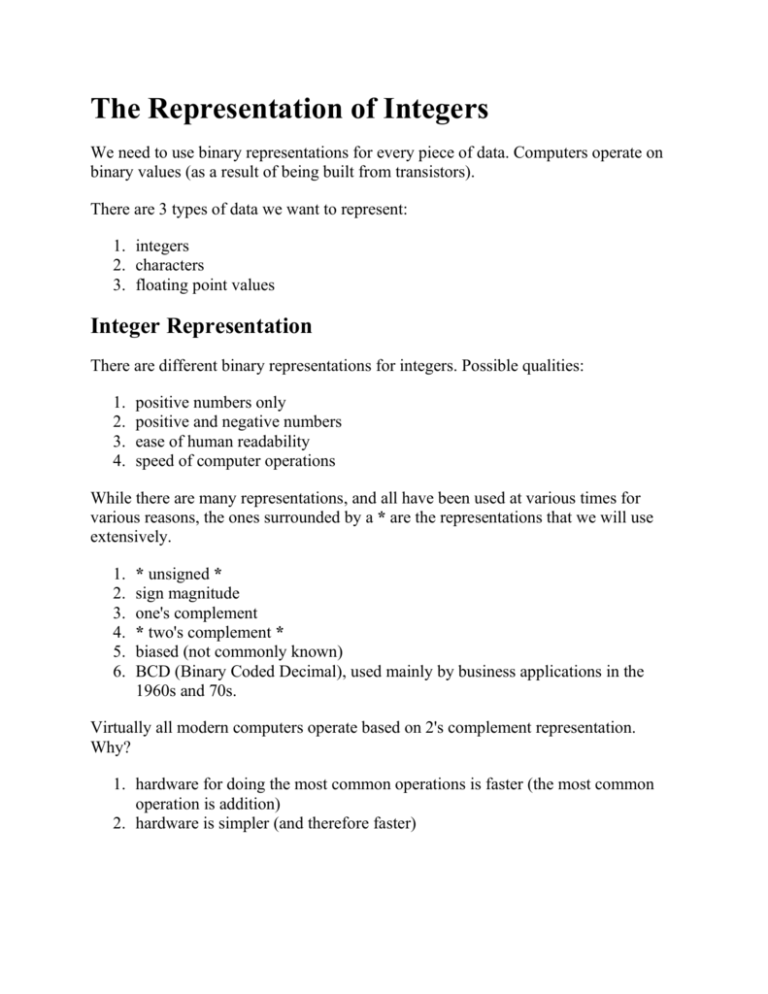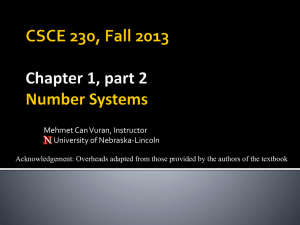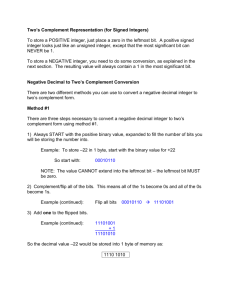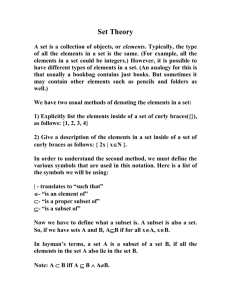File
advertisement

The Representation of Integers We need to use binary representations for every piece of data. Computers operate on binary values (as a result of being built from transistors). There are 3 types of data we want to represent: 1. integers 2. characters 3. floating point values Integer Representation There are different binary representations for integers. Possible qualities: 1. 2. 3. 4. positive numbers only positive and negative numbers ease of human readability speed of computer operations While there are many representations, and all have been used at various times for various reasons, the ones surrounded by a * are the representations that we will use extensively. 1. 2. 3. 4. 5. 6. * unsigned * sign magnitude one's complement * two's complement * biased (not commonly known) BCD (Binary Coded Decimal), used mainly by business applications in the 1960s and 70s. Virtually all modern computers operate based on 2's complement representation. Why? 1. hardware for doing the most common operations is faster (the most common operation is addition) 2. hardware is simpler (and therefore faster) Did you notice that both reasons for using 2's complement representation are the same? Almost always, when discussing why something is done the way it is done, the answer is the same: "because it is faster." Prerequisite Material from 252 (Starts Here) Unsigned Integers the standard binary encoding you already know only 0 and positive values range: 0 to (2^n) - 1, for n bits example: 4 bits, values 0 to 15 n=4, 2^4 -1 is 15 binary decimal hex 0000 0 0 0001 1 1 0010 2 2 0011 3 3 0100 4 4 0101 5 5 0110 6 6 0111 7 7 binary decimal hex 1000 8 8 1001 9 9 1010 10 a 1011 11 b 1100 12 c 1101 13 d 1110 14 e 1111 15 f Prerequisite Material from 252 (Ends Here) One's Complement Integers NOT COVERED IN 354, but you should know it anyway, as it makes understanding Two's Complement easier! Historically important, and we use this representation to get 2's complement integers. Now, nobody builds machines that are based on 1's comp. integers. In the past, early computers built by Semour Cray (while at CDC) were based on 1's comp. integers. Positive integers use the same representation as unsigned. 00000 is 0 00111 is 7, etc. Negation (finding an additive inverse) is done by taking a bitwise complement of the representation. This operation is also known as taking the one's complement. COMPLEMENT. INVERT. NOT. FLIP. NEGATE. This is a logical operation done on a single bit. The complement of 1 is 0. The complement of 0 is 1. Example: Find the representation of -1 in 1's complement representation for +1: complement each bit: 00001 11110 That is -1. Don't add or remove any bits. Example: What decimal value is represented by 11100 ? This must be a negative number. To find out which, find the additive inverse! 00011 is +3 by sight, so 11100 must be -3 Things to notice: 1. any negative number will have a 1 in the MSB 2. there are 2 representations for 0: 00000 and 11111 Prerequisite Material from 252 (Starts Here) Two's Complement integers A variation on 1's complement that does not have two representations for 0. This makes the hardware that does arithmetic (addition, really) faster than for the other representations. a 3-bit example: bit pattern: 100 101 110 111 1's comp: 2's comp.: 000 001 010 011 -3 -2 -1 0 0 1 2 3 -4 -3 -2 -1 0 1 2 3 The negative values are all "slid" down by one, eliminating the extra zero representation. How to get an integer in 2's comp. representation: positive values are the same as for sign mag. and 1's comp. they will have a 0 in the MSB (but it is NOT a sign bit!) positive: just write down the value as before negative: use the positive value take the 1's comp. add 1 00101 (+5) 11010 (-5 in 1's comp) + 1 -----11011 (-5 in 2's comp) To get the additive inverse of a 2's complement integer, 1. take the one's complement 2. add 1 This 2-step operation that results in finding the additive inverse of a two's complement representation is also known as taking the two's complement. To add 1 without really knowing how to add: start at LSB, for each bit (working right to left) while the bit is a 1, change it to a 0. when a 0 is encountered, change it to a 1 and stop. All other remaining bits are the same as before. Example: What decimal value does the two's complement 110011 represent? It must be a negative number, since the most significant bit (msb) is a 1. Therefore, find the additive inverse: 110011 (2's comp. 001100 + 1 -----001101 (after taking the 1's complement) (2's comp. ?) +13) Therefore, its additive inverse (110011) must be -13. A little bit on Adding We'll see how to really do this later, but here's a brief overview. carry in 0 0 0 0 1 1 1 1 a +b -sum a 0 0 1 1 0 0 1 1 b 0 1 0 1 0 1 0 1 sum 0 1 1 0 1 0 0 1 carry out 0 0 0 1 0 1 1 1 0011 +0001 ----0100 It is really just like we do for decimal! 0+0=0 1+0=1 1 + 1 = 2 which is 10 in binary, sum is 0 and carry the 1. 1 + 1 + 1 = 3 sum is 1, and carry a 1. Prerequisite Material from 252 (Ends Here) A Convenient Diagram This diagram is a standard one that is used to point out the differences between a bit pattern (a representation), and the values represented by the bit pattern. This version of the number wheel gives all possibilities of 4-bit representations. For each representation, it also gives (in the outer circles) the decimal value represented by the bit pattern. Notice that positive two's complement values are exactly the same as the unsigned values. It is the bit patterns that have a 1 in the most significant bit position where the values represented differ. Prerequisite Material from 252 (Starts Here) Sign Extension How to change an integer with a smaller number of bits into the same integer (same representation) with a larger number of bits. This is commonly done on some architectures, so it is best to go over it. By representation: unsigned xxxxx becomes 000xxxxx Copy the original integer into the LSBs, and put 0's elsewhere 1's and 2's complement. Called sign extension. Copy the original integer into the LSBs, take the MSB of original integer and replicate it elsewhere. Example: 0010101 -> 000 0010101 ^ ^^^ 11110000 -> 11111111 11110000 ^ ^^^^^^^^ Prerequisite Material from 252 (Ends Here) Overflow Sometimes a value cannot be represented in the limited number of bits allowed. Examples: unsigned, 3 bits: 2's comp., 4 bits: 8 would require at least 4 bits (1000) 8 would require at least 5 bits (01000) When a value cannot be represented in the number of bits allowed, we say that overflow has occurred. Overflow occurs when doing arithmetic operations. example: 011 (3) + 110 (6) --------? (9) 3-bit unsigned representation it would require 4 bits (1001) to represent the value 9 in unsigned rep. This is an issue, as computer hardware is implemented with a fixed precision. The computer cannot utilize additional bits to complete an operation.








